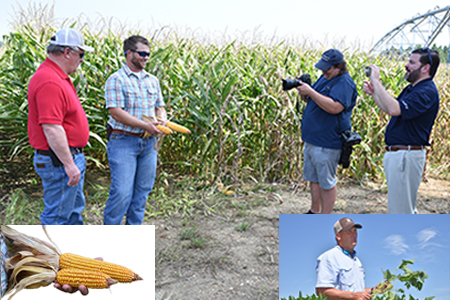Crop Outlook Tour Helps Farmers Share Stories

“If we don’t tell our story, someone else will.”
With those words, Limestone County farmer Jessie Hobbs summarized the purpose of the Alabama Farmers Federation’s Crop Outlook Tour. With stops in Montgomery Aug. 13 and at Hobbs’ Elkmont farm Aug. 16, the event invited the media to hear from farmers about crop conditions, trade and more.
“We routinely receive calls from reporters about how the weather or national policy is affecting Alabama farmers,” said Federation Commodity Director Carla Hornady. “The Crop Outlook Tour gave us a chance to proactively answer those questions while giving reporters more time to visit with farmers than they typically have on a news assignment.”
Hornady, who works with cotton, soybean and grain farmers, conceived the idea with Federation National Affairs Director Mitt Walker. Federation Director of News Services Mary Johns organized the events.
While Hobbs said he expects good yields from his corn, soybeans and cotton, the outlook was very different 200 miles south. Autauga County farmer Drew Wendland showed reporters contrasting ears of corn as he talked about the lack of rainfall.
“These plants came from the same type of seed and both got the same amount of fertilizer,” said Wendland, who hosted the south Alabama tour at fields just across the Alabama River in Montgomery County. “The only difference is irrigation. Without adequate water, not only do the ears not grow as large, they have fewer kernels.”
Although drought conditions were worse in central Alabama, Hobbs said total rainfall across north Alabama varied more than 20 inches. His wettest and driest fields were just 3 miles apart.
“You would think 3 miles is not that far, but sometimes the difference between a good crop and a bad crop is a half-inch of rain at the right time,” he said.
In addition to crop conditions, reporters heard from Hobbs, Wendland and Federation President Jimmy Parnell about a variety of issues ranging from the need to recruit more young farmers to highway safety during harvest season.
Parnell said one of the biggest challenges for current and future farmers is financial stability.
“If you want to talk about the biggest concern in agriculture, it’s profitability,” Parnell said. “Input costs are high, margins are low — very low — and then you have the weather, which can take that small margin away from you in the blink of an eye.”
Reporters attending the Crop Outlook Tour were given commodity facts, agricultural census data and story ideas. They also were provided breakfast featuring foods from local farms.
According to a report compiled by Johns, the Crop Outlook Tour generated 42 mentions in the news media with a potential audience of 2.7 million people. Coverage included three television stations, two newspapers, one television talk show, two statewide news blogs and communicators from four affiliated agricultural organizations.
